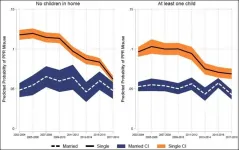(Press-News.org) Scientists have genetically engineered immune cells, called myeloid cells, to precisely deliver an anticancer signal to organs where cancer may spread. In a study of mice, treatment with the engineered cells shrank tumors and prevented the cancer from spreading to other parts of the body. The study, led by scientists at the National Cancer Institute's (NCI) Center for Cancer Research, part of the National Institutes of Health (NIH), was published March 24, 2021, in Cell.
"This is a novel approach to immunotherapy that appears to have promise as a potential treatment for metastatic cancer," said the study's leader, Rosandra Kaplan, M.D., of NCI's Center for Cancer Research.
Metastatic cancer--cancer that has spread from its original location to other parts of the body--is notoriously difficult to treat. Dr. Kaplan's team has been exploring another approach: Preventing cancer from spreading in the first place.
Before cancer spreads, it sends out signals that get distant sites ready for the cancer's arrival--like calling ahead to have the pillows fluffed in your hotel room prior to arrival. These "primed and ready" sites, discovered by Dr. Kaplan in 2005, are called pre-metastatic niches.
In the new study, the NCI team explored the behavior of immune cells in the pre-metastatic niche. Because Dr. Kaplan is a pediatric oncologist, the team mainly studied mice implanted with rhabdomyosarcoma, a type of cancer that develops in the muscles of children and often spreads to their lungs.
To study the pre-metastatic niche, the researchers looked at the lungs of the mice after tumors formed in the leg muscle but before the cancer was found in the lungs. The immune system's natural ability to attack cancer was present but actively stifled in the lungs, the NCI scientists discovered. There were few cancer-killing immune cells, but many cells that suppress the immune system.
Myeloid cells, in particular, were abundant in the pre-metastatic niche and continued to gather there as the cancer progressed. Myeloid cells are part of the body's first response to infection, injury, and cancer. When they detect a threat, they normally make interleukin 12 (IL-12), a signal that alerts and activates other immune cells. But myeloid cells in the lung pre-metastatic niche instead sent out signals that told cancer-fighting immune cells to stand down, the researchers found.
Together, these features of the lung pre-metastatic niche allow cancer cells to thrive when they spread there, Dr. Kaplan explained.
The NCI team wondered if they could take advantage of myeloid cells to spur the immune system into action in the pre-metastatic niche by changing the message they deliver. So, they used genetic engineering to add an extra gene for IL-12 to myeloid cells from lab mice.
"We chose myeloid cells to deliver IL-12 based on their unique ability to home to tumors and metastatic sites," Dr. Kaplan said. "With IL-12, we're turning the volume up on a message that's been quieted."
In mice with rhabdomyosarcoma, these genetically engineered myeloid cells, nicknamed GEMys, produced IL-12 in the primary tumor and in metastatic sites. As hoped, the GEMys recruited and activated cancer-killing immune cells in the pre-metastatic niche and lowered the signals that suppress the immune system, the researchers found.
"We were excited to see that the GEMys 'changed the conversation' in the pre-metastatic niche. They were now telling other immune cells to get ready to fight the cancer," Dr. Kaplan said.
As a result, mice treated with GEMys had less metastatic cancer in the lungs, smaller tumors in the muscle, and they lived substantially longer than mice treated with nonengineered myeloid cells. The researchers found similar results when they studied mice with pancreatic tumors that spread to the liver.
The NCI team also found that, in combination with chemotherapy, surgery, or T-cell transfer therapy, the effects of the GEMy treatment improved. For example, giving mice a single dose of chemotherapy two days before the GEMy infusion cured mice with rhabdomyosarcoma, meaning the treatment completely eliminated all traces of cancer for more than 100 days.
"I have never seen that kind of durable cure in my research before. Typically, cancer growth will slow down after treatment but then it will come back with a vengeance," Dr. Kaplan said.
The team also found evidence that the chemotherapy and GEMys combination might prevent cancer from coming back. When the researchers reintroduced cancer cells into mice that had been cured by the combination treatment, tumors didn't form. This suggests that the combination treatment leaves a long-lasting "immune memory" of the cancer, the researchers explained.
As a final step in their study, the researchers created GEMys from human cells grown in the lab. In lab dishes, the genetically engineered human cells produced IL-12 and activated cancer-killing immune cells.
The team plans to test the safety of human GEMys in a clinical trial of adults with cancer and, if it proves to be safe, in children and adolescents with cancer. There are many unanswered questions they hope to explore, including whether the homing pattern of GEMys is similar in humans and mice, and whether IL-12 from the GEMys will cause side effects in patients.
But the researchers are reassured by several factors. "We are delivering a small amount of IL-12 that's similar to the body's natural response to an infection, creating a ripple effect of immune activation against the cancer. In addition, GEMys don't multiply rapidly inside the body, so they're not flooding the system with IL-12," explained Sabina Kaczanowska, Ph.D., first author of the study. These are important considerations because high levels of IL-12 throughout the body can be toxic.
"Although there are challenges of planning a first-in-human trial of a cell therapy, I'm grateful to have access to the resources of the NIH Clinical Center and to be able to lean on the experience of my NCI colleagues who have had decades of experience developing cell therapies for cancer," Dr. Kaplan added.
INFORMATION:
About the Center for Cancer Research (CCR): CCR comprises nearly 250 teams conducting basic, translational, and clinical research in the NCI intramural program--an environment supporting innovative science aimed at improving human health. CCR's clinical program is housed at the NIH Clinical Center--the world's largest hospital dedicated to clinical research. For more information about CCR and its programs, visit ccr.cancer.gov.
About the National Cancer Institute (NCI): NCI leads the National Cancer Program and NIH's efforts to dramatically reduce the prevalence of cancer and improve the lives of cancer patients and their families, through research into prevention and cancer biology, the development of new interventions, and the training and mentoring of new researchers. For more information about cancer, please visit the NCI website at cancer.gov or call NCI's contact center, the Cancer Information Service, at 1-800-4-CANCER (1-800-422-6237).
About the National Institutes of Health (NIH): NIH, the nation's medical research agency, includes 27 Institutes and Centers and is a component of the U.S. Department of Health and Human Services. NIH is the primary federal agency conducting and supporting basic, clinical, and translational medical research, and is investigating the causes, treatments, and cures for both common and rare diseases. For more information about NIH and its programs, visit nih.gov.
What The Study Did: Researchers evaluated the association between a recent diagnosis of mild cognitive impairment or dementia and the risk of attempting suicide among older adults.
Authors: Amy L Byers, Ph.D., M.P.H., of the University of California, San Francisco, is the corresponding author.
To access the embargoed study: Visit our For The Media website at this link https://media.jamanetwork.com/
(doi:10.1001/jamapsychiatry.2021.0150)
Editor's Note: The article includes conflict of interest and funding and support disclosures. Please see the article for additional information, including other authors, author contributions and affiliations, conflict of interest and financial ...
What The Study Did: This comparative effectiveness research study that included a high proportion of non-White individuals assesses whether remdesivir administered alone or with corticosteroids is associated with time to clinical improvement or time to death in patients hospitalized with confirmed COVID-19.
Authors: Brian T. Garibaldi, M.D,. M.E.H.P., of the Johns Hopkins University School of Medicine in Baltimore, is the corresponding author.
To access the embargoed study: Visit our For The Media website at this link https://media.jamanetwork.com/
(doi:10.1001/jamanetworkopen.2021.3071)
Editor's Note: The article includes conflict of interest and funding/support disclosures. ...
What The Study Did: This survey study investigated the frequency and nature of sexist and racial/ethnic microaggressions against female and racial/ethnic-minority surgeons and anesthesiologists and the association with physician burnout.
Authors: Neha T. Sudol, M.D., of the Southern California Permanente Medical Group in Irvine, is the corresponding author.
To access the embargoed study: Visit our For The Media website at this link https://media.jamanetwork.com/
(doi:10.1001/jamasurg.2021.0265)
Editor's Note: The article includes funding/support disclosures. Please see the article for additional information, including other authors, author contributions and affiliations, conflict of interest and financial ...
Female adult sockeye from the Fraser River are dying at significantly higher rates than their male counterparts on the journey back to their spawning grounds, finds new UBC research. For every male salmon that doesn't make it to their natal stream, at least two, sometimes three female salmon die.
"This is causing skewed sex ratios in their spawning grounds, something that has been observed in recent years," says lead researcher Dr. Scott Hinch, a professor in the faculty of forestry and head of the Pacific Salmon Ecology and Conservation Laboratory at UBC. "The implications on the health of Fraser River stocks are concerning, particularly as Pacific ...
Three-dimensional or "volumetric" images are widely used in medical imaging. These images faithfully represent the 3D spatial relationships present in the body. Yet 3D images are typically displayed on a two-dimensional monitor, which creates a dimensionality mismatch that must be resolved in a clinical setting where practitioners must search a 2D or a 3D image to find a particular trait or target of interest.
To learn more about this problem, Craig K. Abbey, Miguel A. Lago, and Miguel P. Eckstein, of the Department of Psychological and Brain Sciences at University of California Santa Barbara, used techniques from the field of vision science to examine how the observers use information in images to perform a given task. Their research, published in the Journal of ...
Syracuse, N.Y. - As opioid use disorders and overdoses continue to skyrocket in the United States, a study by researchers from Syracuse University and Pennsylvania State University shows that unmarried young adults who do not have children are mostly likely to misuse opioids.
The growing number of these "disconnected" young adults may also result in continued rises in substance use disorders and overdoses, the researchers say. The study, "Opioid misuse and family structure: Changes and continuities in the role of marriage and children over two decades," was published ...
Living tissue can heal itself from many injuries, but giving similar abilities to artificial systems, such as robots, has been extremely challenging. Now, researchers reporting in ACS' Nano Letters have developed small, swimming robots that can magnetically heal themselves on-the-fly after breaking into two or three pieces. The strategy could someday be used to make hardier devices for environmental or industrial clean up, the researchers say. Watch a video of the self-healing swimmers here.
Scientists have developed small robots that can "swim" through fluids ...
Today, Cochrane, a global independent network that gathers and summarizes the best evidence from research to help informed health decision-making, publishes an updated systematic review assessing rapid tests for the detection of SARS-CoV-2 infection (COVID-19). The review shows that rapid antigen tests are better at correctly identifying cases of COVID-19 in people with symptoms than in people without symptoms. There are large differences in the accuracy of different brands of test, with very few meeting the World Health Organization (WHO) minimum acceptable performance standards.
During the COVID-19 pandemic, swift diagnosis of people who are infected with SARS-CoV-2 is important. Then decisions ...
The more nitrate there is in mothers' drinking water, the smaller the babies they give birth to. But alarmingly, the declining birth weight can also be registered when the women are exposed to nitrate levels below the EU's threshold of 50 milligrams of nitrate per litre.
This is shown by a register-based study of more than 850,000 births in Denmark carried out in a Danish-American partnership led by Professor Torben Sigsgaard from the Department of Public Health at Aarhus University and Professor Leslie Stayner and Dr. Vanessa Coffman from the Division of Epidemiology and Biostatistics at the University of Illinois at Chicago, School of Public Health.
On the ...
March 24, 2021 - For premature infants who can't breastfeed on their own, "mother's own milk" (MOM) is by far the best nutrition. There's an urgent need for effective ways to increase the relatively low rates of MOM feeding for preterm infants born to Black and Hispanic mothers. But so far, research has offered little or no specific guidance, concludes an evidence-based review in Advances in Neonatal Care, official journal of the National Association of Neonatal Nurses. The journal is published in the Lippincott portfolio by Wolters Kluwer.
Until studies of targeted, culturally appropriate interventions are performed, available evidence points to some promising approaches to overcoming obstacles and facilitating ...



